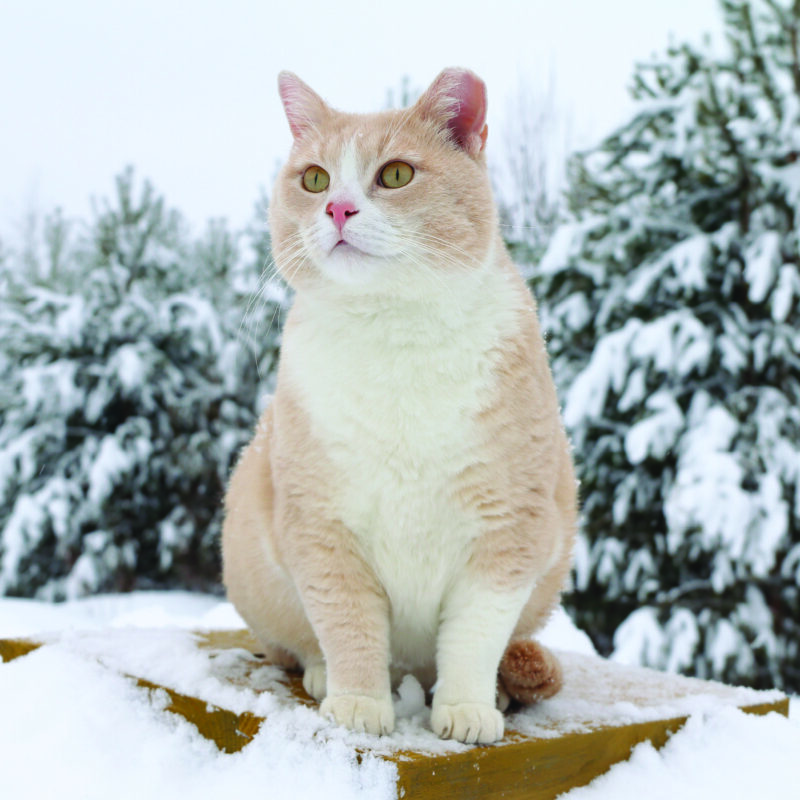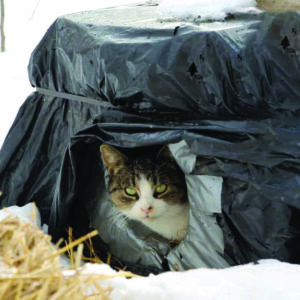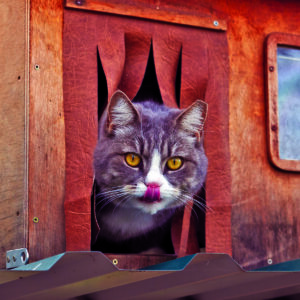
It’s a special episode! Part Two of The Drop Trap: A Trapper’s Best Friend Presented by Neighborhood Cats
December 26, 2023
Spurring Change for Cats from the Top Down with Jonlyn Freeman, Founder of NYC Cat Rescuer Alliance and Meagan Licari, President of Puppy Kitty NY City
January 2, 2024
As the chill of winter approaches, our thoughts turn to outdoor cats, particularly those without a dedicated home or owner. For those who face cold, hard, and long winters, now is the perfect time to start thinking about winterizing outdoor cat shelters. In this article, we’ll explore how to prepare shelters, provide essential care, and support our feline friends during the cold season.
Sheltering an Outdoor Cat

This photo is of a fantastic winter shelter used by Neighborhood Cats. You can find plans for many different DIY winter shelter designs and other seasonal care advice on neighborhoodcats.org. Check it out!
The welfare of feral and outdoor cats is a responsibility that many of us take seriously. One of the first steps to ensure their well-being is to clean and prepare their shelters and feeding stations for the approaching winter.
Cleaning the shelters thoroughly is crucial, providing a safe and hygienic environment for the cats. After cleaning, opt for fresh straw instead of hay. Straw is hollow and stays dry and warm regardless of the elements. Hay, however, is just dried grass, which tends to become a soggy mess, absorbing moisture and becoming cold and uncomfortable. Additionally, hay has the potential to develop mold.
It’s important to note that although blankets and newspapers may seem like suitable choices, both materials also tend to become soggy and retain a significant amount of water (and may even freeze).
By using plenty of fresh straw, we can ensure that our feline companions have warm, safe, and cozy places to seek refuge from the winter cold.
Access to Food and Water
As the temperature drops, it’s essential to think about the type and quantity of food you provide to outdoor cats. For instance, if using dry food in the winter, consider adding dry kitten food for a few extra calories, as cats need more calories in the winter to stay warm.
While some feeders may opt solely for dry food, as it’s less likely to freeze, it’s crucial to consider the hydration needs of cats during the winter. Hydration can be challenging for outdoor cats, and providing wet food can make a significant difference in their well-being.
 Don’t forget to address the issue of freezing water. It’s essential to find ways to prevent water from freezing quickly to ensure that cats have access to clean drinking water. Here are a couple of options to keep water from freezing, which can be a lifesaver for outdoor cats:
Don’t forget to address the issue of freezing water. It’s essential to find ways to prevent water from freezing quickly to ensure that cats have access to clean drinking water. Here are a couple of options to keep water from freezing, which can be a lifesaver for outdoor cats:
- The Right Kind of Bowl: The type of bowl you use can affect the speed at which water freezes. Containers with thick plastic walls, deeper bowls with narrower openings, and dark-colored bowls can help delay freezing.
- Tires and Rocks: Fill an old black tire (without its rim) with rocks and tightly wedge a large bucket in the tire’s hole. During the day, the tire absorbs sunlight, heating the rocks and preventing the water from freezing.
- Heating Pipes: In urban areas, some back alleys may have heating pipes just inside the exterior walls of neighboring buildings. Placing a water bowl near these areas can slow freezing.
- Hand Warmers: Place hand warmers between two bowls to keep the water warm.
- Thermos: Refreshing water bowls using warm water from a thermos can also help keep water from freezing.
By implementing these innovative solutions and providing care to outdoor cats during winter, you can make a significant difference in their lives, ensuring that they have access to warm shelter, food, and unfrozen water during the colder months.
What to Watch Out For in Winter
Cats are resourceful in finding warm spots, sometimes hiding under vehicles. To prevent accidents, always tap the hood and honk the horn before starting your car.
Just as with our skin, the winter season can cause dry and flaky skin in cats due to indoor heating. Proper diet and nutrients contribute to skin and coat health from the inside out. One option to consider is adding salmon oil to their food, which is great for their skin and overall health.
 Plan for bad weather. If a major weather event like snow accumulation is in the forecast, give cats extra food and water in case you can’t get to the colony for a period of time.
Plan for bad weather. If a major weather event like snow accumulation is in the forecast, give cats extra food and water in case you can’t get to the colony for a period of time.
By taking these precautions and preparing, you’ll ensure that community cats enjoy a happy, healthy life throughout the winter and all year round.
Summary
By diligently winterizing shelters, providing nourishing food, and addressing the challenges of freezing water, we can substantially impact outdoor cats’ well-being. Remember to stay vigilant during winter, considering unexpected hideouts cats might seek, taking precautions with vehicles, and monitoring their skin health.
If you have questions or want to deepen your knowledge of community cat care, sign up for our TNR (Trap-Neuter-Return) certification workshop. This workshop provides an opportunity to ask the experts at Neighborhood Cats any questions you may have.
To get started, check out our YouTube video on Colony CareTaking Tips and Tricks. Here, you’ll find valuable insights and practical advice on ensuring the well-being of outdoor cats during the winter months.
Let’s join hands in creating a season of care, compassion, and well-deserved comfort for our community cats.
 This article was contributed by Kendall Wapner • With a fervent dedication to animal welfare, Kendall has been an advocate for the rights and well-being of animals since 2013. Over the years, she has contributed to the cause in various capacities, ranging from hands-on work in animal shelters to orchestrating impactful exhibitions aimed at raising awareness for animal rights. Currently collaborating with the Community Cats Podcast, Kendall is excited to amplify the message of the critical importance of spaying and neutering cats, particularly through Trap-Neuter-Return (TNR) initiatives. Through Kendall’s multifaceted engagement in the realm of animal advocacy, they aim to inspire positive change and foster a compassionate understanding of the needs of our furry companions.
This article was contributed by Kendall Wapner • With a fervent dedication to animal welfare, Kendall has been an advocate for the rights and well-being of animals since 2013. Over the years, she has contributed to the cause in various capacities, ranging from hands-on work in animal shelters to orchestrating impactful exhibitions aimed at raising awareness for animal rights. Currently collaborating with the Community Cats Podcast, Kendall is excited to amplify the message of the critical importance of spaying and neutering cats, particularly through Trap-Neuter-Return (TNR) initiatives. Through Kendall’s multifaceted engagement in the realm of animal advocacy, they aim to inspire positive change and foster a compassionate understanding of the needs of our furry companions.




